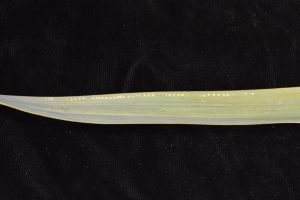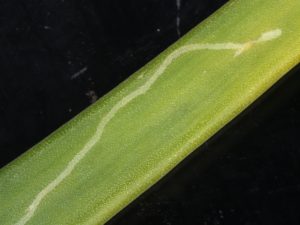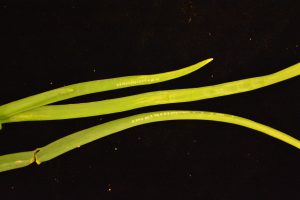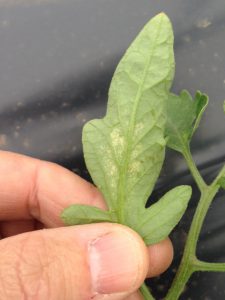Two probable infestations of allium leafminer have been discovered. One of these was on the Hunterdon/Warren County border involving overwintered garlic and onions planted this spring. The second, a very minor infestation, was found near Princeton in Mercer County on overwintered chives. While we await word from USDA as to where specimens should be sent for final confirmation, the signs of infestation are very characteristic of allium leafminer, and larvae and eggs were found in association with the egg laying scars (oviposition scars) on the leaves of onions and garlic. Both of these infestations appear to be very recent, with larvae in very early growth stages. [Read more…]
Vegetable Crops Edition
Seasonal updates and alerts on insects, diseases, and weeds impacting vegetable crops. New Jersey Commercial Vegetable Production Recommendations updates between annual publication issues are included.
Subscriptions are available via EMAIL and RSS.
Quick Links:
 NJ Commercial Vegetable Production Recommendations
NJ Commercial Vegetable Production Recommendations
 Rutgers Weather Forecasting - Meteorological Information important to commercial agriculture.
Rutgers Weather Forecasting - Meteorological Information important to commercial agriculture.
Pest Alert: Probable Allium Leafminer infestations found in NJ
Vegetable Disease Briefs – 5/11/16
- Rhizoctonia root rot has been found on newly emerged cucurbit seedlings. The cool, cloudy weather has significantly slowed emergence and transplant growth the past few weeks. The longer it takes for emergence and transplants to establish themselves, the more likely they are to pick up pre- and post-emergent damping-off diseases such as Rhizoctonia or Pythium.
- Botrytis is being reported in greenhouse tomatoes and in strawberries fields. The weather the past few weeks has been ideal for its development in a multitude of crops. Growers need to scout on a regular basis and incorporate Botrytis specific fungicides into their weekly maintenance sprays as long as the current weather pattern remains the same.
- Transplant health – transplants that have yet to be put in the field and that are showing signs of stress via the lack of fertility and water to keep them to size can become predisposed to a multiple of opportunistic fungal and bacterial pathogens. Growers need to pay close attention to and adjust fertility and watering programs on a daily basis and consider preventative fungicide applications.
Veg IPM Update: Week Ending 5/11/16
Two-spotted spider mite (TSSM) infestations have recently been discovered in high tunnels.
TSSM feeding results in small white pin-spots on the upper leaf surface (see photos). Mites are actually underneath leaves. These pests can increase dramatically in the warm, dry environment of the tunnel.
Check 5 plants each in 5 separate locations in the tunnel. Inspect the entire plant, and be sure to check the underside of leaves that display the whitish mite feeding. If mites are found, it is best to immediately treat. TSSM is much more easily managed, when the problem is addressed at low levels. If allowed to spread throughout the tunnel, TSSM will be much more difficult to control.
See the 2016 Commercial Vegetable Production Recommendations – Pest Management section for materials that are labeled for use in greenhouse structures, including those that are OMRI approved.
[Read more…]
Using Orondis Gold 200
Orondis (oxathiapiproplin, U15) targets the oxysterol binding protein that is a part of the cell wall. The active ingredient inhibits growth of the fungus as well as sporangia production and zoospore germination. Orondis has a low solubility (i.e., locally systemic), is translaminar; and will protect new growth. Orondis is currently sold as a co-pack with either mefenoxam (Orondis Gold), chlorothalonil (Orondis Opti), or mandipropamid (Orondis Ultra). Growers will be required to tank mix Orondis with its partner during 2016 season. In 2017, the partners will be formulated together. Orondis has different use rates and restricted seasonal use. The rates for Orondis and it counterpart will differ by crop, pathogen, and desired use (drip vs. foliar). Unfortunately, because of its registration date, Orondis was not included the 2016 Mid-Atlantic Commercial Vegetable Production Guide.
Orondis Gold 200 (oxathiapiprolin [OXTP] + mefenoxam, U15 + 4) — Growers using Orondis Gold will need refer to the Orondis Gold 200 (OXTP) label and the Orondis Gold B (mefenoxam) label.
Orondis Gold 200 targets damping-off caused pythium and/or phytophthora in cucurbits and fruiting vegetables (pepper, tomatoes, eggplant), and leafy vegetables (excluding brassica’s).
Orondis, a new Fungicide from Syngenta
Syngenta Crop Protection released Orondis, a new fungicide with a new mode-of-action for use in vegetable production this past winter. Because of its winter registration, Orondis was not included the 2016 Mid-Atlantic Commercial Vegetable Production Guide.
Orondis (oxathiapiproplin, U15) targets the oxysterol binding protein that is a part of the fungal cell wall. The active ingredient inhibits growth of the fungus as well as sporangia production and zoospore germination. Orondis has a low solubility (i.e., locally systemic), is translaminar; and will protect new growth.
Orondis is currently sold as a co-pack with either mefenoxam (Orondis Gold), chlorothalonil (Orondis Opti), or mandipropamid (Orondis Ultra). Growers will be required to tank mix Orondis with its partner during 2016 season. In 2017, the partners will be formulated together. Importantly, Orondis will not receive an individual label in the US.
Orondis has different use rates and restricted seasonal use. The labels need to be followed carefully and accordingly to help manage fungicide resistance development. Simply, if Orondis is applied via drip system, it cannot be used as a foliar spray (and visa-versa). If Orondis is applied as a foliar application it cannot be used via the drip. Thus, growers planning on using Orondis need to plan ahead of time and accordingly! The rates for Orondis and it counterpart will differ by crop, pathogen, and desired use (drip vs. foliar). [Read more…]
New Downy Mildew Grant Award will Aid Growers
For the past 6 years, Rutgers has led efforts in the breeding of sweet basil for resistance to downy mildew. Currently, basil downy mildew threatens 100% of the basil acreage in the US and other parts of the world.
Rutgers University, along with researchers at Michigan State, University of Florida, Oregon State University, Cornell University, California State University, and North Carolina State University as well as the USDA Agricultural Research Service have been awarded a $2.3-million USDA grant to help fight downy mildew in a number of highly valuable crops. The announcement from MSU who leads this effort can be found on MSU Today.




